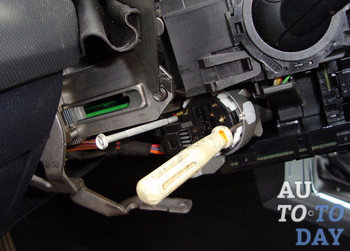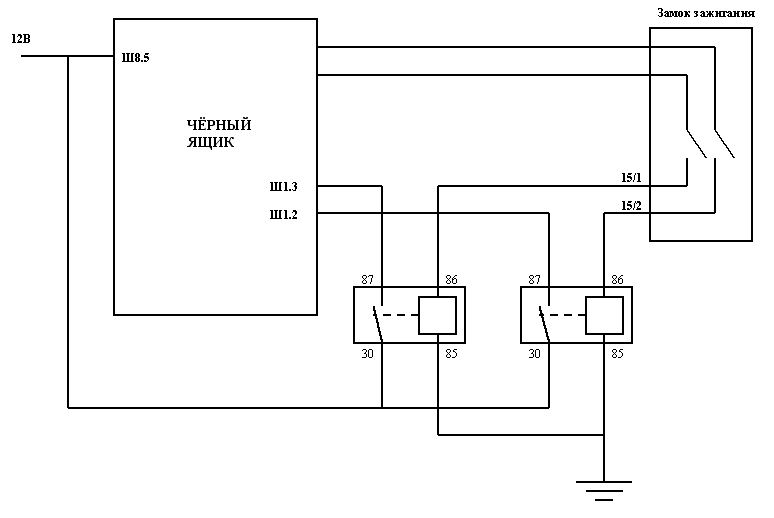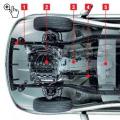The machine was not always complicated, and on old models, in principle, the operation of most systems could be understood even by a person who was far from technology and even more from professional repair. - one of those that has the most simple device, and whose principle of operation is clear even to a simple layman. Today we will tell you what an ignition switch contact group is and how it works.
Appointment
In terms of the driver, this is an ordinary keyhole. By inserting the key into it and turning it to the desired position, you can make the electrician of the iron horse work or start the engine.
There are several operating modes of the ignition lock on modern foreign cars. The first position is zero. At the same time, all the electrical and comfort systems do not work, and the key can be freely inserted or removed.
On some models, the feature is that when the key is inserted, not turned from its original position, the electrician starts to work. For example, such an operation turns on the radio and climate control, activates the mirror control systems or the glass drive.
By turning the key one position, you can turn on part of the electrical, in the same way as described in the previous paragraph. Often such a system is designed so that not all of the electrician is activated in this position, but only part of it. So, for example, when the radio is activated, it may not work climate control, headlights, wipers, etc. Non-working systems also include heating rear window, and electric parking brakeas consumers of excessive amounts of power.
The next mode is the complete activation of all electrics. At the same time, the overwhelming number of all systems that do not take part in ensuring the movement of the machine itself begin to work. This list includes all comfort, heating and air conditioning systems.
The latter mode provides engine start. Its peculiarity lies in the fact that the ignition lock cannot be fixed in the start position; the key can be held for a short enough time until the engine starts. When the key is held in the extreme position, the ignition system is fully activated. Power battery converted to d.C. high voltage is applied to the spark plugs and produces a spark, which causes the engine to immediately start working.
Device and principle of operation
In the previous section, we figured out how to work with the ignition switch and what functions it performs. Now it is worth answering the question, why do we need an ignition switch contact group and how does it work?
By its design, the contact group is a switch that provides the closure of the required set of wires. In other words, the lock is an ordinary switch that, depending on the mode of operation, closes one or more circuits connecting various controls.
For example, in the first mode of operation, power is supplied to the radio tape recorder and headlights, and in the second - to the climate control systems, air conditioning and power accessories for glasses and mirrors.
Generally speaking, the contact group carries out the work of the car's electrics in two modes - battery and generator. In the first case, the electrical circuit originates from the positive terminal of the battery, passes through all the necessary consumers and closes at the negative terminal. With a generator circuit for providing voltage, power is taken directly from the generator, and only then is it transmitted to the consumer through the wiring system. IN modern cars these two modes are applied together, and such a solution takes place.
So, it is worth noting that when the engine is off, the electrical and most heating systems do not work. This is due to the fact that the voltage consumption of these systems is too high, and the battery simply will not pull the required power.
The principle of operation of the contact group when starting the engine deserves a separate word. In this case, while holding the key in the extreme position, only one electrical circuit is closed. It is she who supplies high voltage to the candle.
Thus, the battery feeds where it gets high enough to ignite the fuel in the cylinders. Further, the current is sent to the distributor-breaker and candles, where ignition is carried out. At the same time, the contact group supplies voltage to the starter, which scrolls and starts.
Start the car engine? Nothing seems to be complicated. Turning the key in the ignition lock and stable engine noise indicate that the car is ready to move. But this procedure does not always work like this. Most car owners have faced such a problem when the answer to turning the key is complete silence. power plant... This silence is most often caused by a problem.
What is the ignition contact group and what happens when the key is turned
Turning the key in the ignition and starting the engine - it would seem, what could be easier? But this is from the driver's point of view, and from the inside of the car at this time, in a matter of moments, a considerable number of very significant actions are performed. The ignition system consists of many elements, but in today's article we will talk about the mechanism that connects the wires and closes the contacts needed to start and stop the engine. This mechanism is named.
![]() A contact group is a connecting system of electrical wires' contacts, which makes it possible to close them in the required sequence, which ensures the distribution of the current supply from the power source to various electrical appliances of the machine.
A contact group is a connecting system of electrical wires' contacts, which makes it possible to close them in the required sequence, which ensures the distribution of the current supply from the power source to various electrical appliances of the machine.
What does the contact group of the ignition switch consist of?
The ignition switch is a conventional electrical circuit breaker. The ignition key performs the task of regulating the position of the contacts, thereby providing the opportunity to select a number of alternatives for connecting the chains: starting the engine, powering electrical appliances, stopping the engine.
If you remove the ignition switch cover, you will be able to inspect the device itself: the lock and a large number of wires, which are combined according to the "plug-socket" principle. The wires go from the power source (battery) and combine all the electrical appliances of the machine into a single chain. The contact group goes to the junction for electrical wires. For the purpose of isolation and demarcation, the wiring contacts are fixed in the plastic case of the contact group.
What is a contact group for?
In essence, a contact group is needed in order to comfortably connect absolutely all electrical circuits of the machine, group them and change them if wear has occurred. Often, as a result of the deterioration of the insulation of the wires, a short circuit can form, and the working chain of electrical wires will open. Perhaps it would be better to connect the contacts directly to the ignition lock, but in this case it would be necessary to disassemble the lock case each time and solder the new contacts. It will be much easier and more economical to replace the contact group.
How the contact group of the ignition switch functions
 There are two types of ignition systems: battery and generator.
Their difference is that the battery ignition has an autonomous power source, and the electrical appliances of the machine can be turned on without starting the motor. Generator ignition makes it possible to use electrical appliances only after starting the engine, when the formation of electric current starts.
There are two types of ignition systems: battery and generator.
Their difference is that the battery ignition has an autonomous power source, and the electrical appliances of the machine can be turned on without starting the motor. Generator ignition makes it possible to use electrical appliances only after starting the engine, when the formation of electric current starts.
When the ignition key is turned, the electrical circuit is closed from the “-” terminal on the battery to the inductive ignition coil. Electricity is passed through the wire system to the ignition lock, through the contacts of the lock passes to the inductive coil and returns to the "+" terminal. During this period, when electricity flows through the coil, it generates the highest voltage and supplies it to the spark plug. As a result, the key closes the contacts of the ignition circuit and starts the engine. In addition to the ignition circuit, there are many other electrical circuits in the car that conduct electricity from the key to the electrical equipment. For the purpose of separating these chains, a contact group is used.
The contact group is responsible for connecting the wire contacts to each other. Each of them is responsible for their own group of electrical equipment. There are several positions in which the key can be in the lock. In position A, a circuit is formed from the power source to the voltage distributor, as a result of which the electrical appliances are activated. With battery ignition, this key position allows you to turn on the headlights, interior lighting, and also use absolutely everything electrical devices... The voltage will be supplied directly from the battery to the distributor. Turning the key to the next position will start the motor as described earlier. Turning the key back will stop the motor.
On different cars, the ignition locks can have different modes depending on the position of the key. Some cars will turn on the voltage as soon as the key is inserted into the lock. In this case, the very presence of the key closes the voltage supply circuit. It is the position of the key in the lock that is responsible for the operation, for example, of the car's anti-theft systems, door locking and alarm.
Change the contact group
 Contact group burnout occurs quite often. As a rule, this happens due to voltage surges from one contact to another. When turning the ignition key, sudden voltage drops are traced, especially when the engine is started, which leads to an increase in the temperature of the electrical wire material - the insulating material burns out.
Contact group burnout occurs quite often. As a rule, this happens due to voltage surges from one contact to another. When turning the ignition key, sudden voltage drops are traced, especially when the engine is started, which leads to an increase in the temperature of the electrical wire material - the insulating material burns out.
To protect the contact group from burnout, an auxiliary unloading relay can be installed, which will remove a fraction of the overload when the motor starts. But for certain machines, for example, Daewoo nexiaburnout of the contact group is considered a "chronic disease." In this case, it is necessary to replace it. Replacing a contact group is quite easy: you need to disassemble the old group and install a new one, while all contacts, without exception, need to be connected in the same way as the previous ones. The connection diagram can be found in the operating instructions for the machine.
The sequence of replacing a burnt out contact group of the ignition switch:
1. First you need to disconnect the battery terminals;
2. Then we unscrew the screws securing the plastic steering column cover and remove it;
3. We unscrew the screws (two pieces) holding the lock;
4. We put the key in the ignition lock in the "0" state, which disables the anti-theft device;
5. When turning off the lock from the network, mark the wiring contacts;
6. Having removed the locking ring, disconnect the contact group from the lock and change it;
7. We collect and mount the castle in its place, this is done in reverse order.
Causes of malfunctions of the contact group of the ignition lock
 Sooner or later, the contact group in the ignition lock of absolutely all cars begins to "show teeth", and then completely refuses to connect the necessary electrical circuits. What can lead to such breakdowns? All reasons for the malfunction of the contact group in the ignition lock can be divided into two types: electrical and mechanical.
Sooner or later, the contact group in the ignition lock of absolutely all cars begins to "show teeth", and then completely refuses to connect the necessary electrical circuits. What can lead to such breakdowns? All reasons for the malfunction of the contact group in the ignition lock can be divided into two types: electrical and mechanical.
Causes of electrical problems in the contact group
The main reason, regarding the electrics, for which the contact group of the ignition switch is capable of failing is its overload. Often, due to the installation of additional equipment or devices with enormous power, such an electric discharge begins to pass through the contacts of the group, which, in principle, they should not carry. For some time, the metal of the contacts withstands such a load, and then it begins to be covered with carbon deposits. Moreover, most often this carbon deposit is formed not outside the contact, but directly from the inside of the metal. In this case, it is impossible to clean it up, and therefore it is impossible to repair such a contact group.
To avoid overloading the contact group of the ignition lock, it is necessary to connect accessories to it via a relay. Then the power current will not burden the group, and its contacts will remain intact.
Not in all cars the electrical congestion of the group is considered the result of the owner's manipulations; in certain cars, a similar phenomenon arises already at the factory. This applies, for example, to the VAZ-2106, where the current is supplied to the starter retractor relay directly from the lock. The contact group "Zhiguli" for some reason does not provide for this type of connection, so the owners of the "sixes" have to replace the contact group from time to time due to the starter contact burnt out. The way out of this kind of situation is the same - the starter must be connected via an unloading relay.
 Another electrical circumstance, due to which the contacts of the group have every chance of burning, is a short circuit in the wiring of the machine. With an unfortunate confluence of factors, up to the blown fuse, a large short-circuit current can damage the contacts, and the group will thus also break.
Another electrical circumstance, due to which the contacts of the group have every chance of burning, is a short circuit in the wiring of the machine. With an unfortunate confluence of factors, up to the blown fuse, a large short-circuit current can damage the contacts, and the group will thus also break.
Causes of mechanical problems in the contact group
The leading mechanical factor, according to which the group can malfunction or fail altogether - wear of the contact tracks and the contacts themselves. This happens, as a rule, from old age, however, it happens, this is due to the use of low-quality metal. The "best" result is the wear of the tracks of the contact group in the VAZ-2106 for 5 months. In less than six months, the metal of the tracks was worn out to such an extent that grooves appeared in them, the group stopped working, and there was a lot of metal sawdust inside it! It is unrealistic to repair such a contact group.
Another mechanical reason is the breakdown of contacts or other elements of the group. For example, on the VAZ "classics" there are groups, in which the starter contact is an iron tongue. Any time the motor is started, this contact moves over the other, "stationary", and bends. As a result of repeated bending, the tongue breaks off or ceases to properly press against the immovable contact, and the car stops starting.
 The last factor in the field of mechanics is the violation of the structure of the group due to powerful heating. This factor is based on the electrical overload described earlier. If too much current flows through the contacts of the lock group, they will overheat. If the plastic of the group body is not best quality, contact tracks have every chance to move, or even fall off. All of the above will undoubtedly disable the contact group.
The last factor in the field of mechanics is the violation of the structure of the group due to powerful heating. This factor is based on the electrical overload described earlier. If too much current flows through the contacts of the lock group, they will overheat. If the plastic of the group body is not best quality, contact tracks have every chance to move, or even fall off. All of the above will undoubtedly disable the contact group.
How to connect contacts to the ignition switch
If the repair of the lock is completed, or a new lock has been purchased, it must be connected and put into place. It is very easy to do this, especially if, during the disconnection of the wires from the terminals of the lock, they were marked for you, or, even better, if the tangle of wires ends with a solid chip. If not, it doesn't matter.
As a rule, there are markings in the terminal block of the lock that can help you connect the cable to the terminals correctly. Automotive manuals will certainly indicate which cable of one color or another is connected to the terminal with a specific indication. We will analyze the connection, for example, of the VAZ terminal block (2101-2107).
Your wiring bundle should consist of a double black cable, a single pinkish cable, a double blue cable, a single brown cable, and a single red cable. We take the cable and alternately, starting with black, we connect them to the terminals with the designations: 1NT, 30, 15, 30/1, 50. The contacts are connected, and we can put the lock in its place.
 When installing the lock, we perform the above actions in the reverse order: we put the lock in seat until the latch clicks, tighten the screws, return the upper and lower parts of the casing to their place. The repair has been completed, but now it is necessary to make sure of its success.
When installing the lock, we perform the above actions in the reverse order: we put the lock in seat until the latch clicks, tighten the screws, return the upper and lower parts of the casing to their place. The repair has been completed, but now it is necessary to make sure of its success.
Checking the operation of the ignition lock after installation
To make sure that all contacts, without exception, are connected correctly, we need to reconnect the "-" terminal of the battery, and enter the key into the ignition switch. When setting the ignition key to the "0" state, all mechanisms of the system must be turned off. If the key is moved to the “I” state, the engine starts and power is supplied to the electrical appliances. In state "II" a start is added to this.
Take an interest in the anti-theft device rod. When moving the key from position "0" to position "I" and back, it will protrude and step back. As you can see from the article, there is nothing difficult in replacing a faulty ignition switch. With some perseverance and aspiration, you will be able to eliminate faults without the help of others, without resorting to the support of professionals.
Subscribe to our feeds in
It is rather difficult to answer this question in one small sentence. Over the long period that has passed since the beginning of the production of cars, many different improvements have been made to the device. If it was enough for the first vehicles to short-circuit a pair of wires to be able to start moving, then modern systems already commute several wires.
At first glance, everything seems simple. I put the key in the ignition switch, turned it and drove off. Most drivers think so, but in reality it is not. To enable the machine to move, several units and mechanisms are involved, the work of which needs coordination and control. Such a control element is the contact block of the ignition lock.
The group of contacts in the ignition lock is a system for connecting wires in the desired sequence and order, for this there is a start, ignition and parking position. This achieves the correct distribution onboard voltage from the current source, which is the battery in the car, to the consumers. There are many of them in a modern vehicle, they include ignition and engine start systems, lighting, signaling, control, monitoring, and security systems.
The contact group works in conjunction with the ignition lock, in some cases, when the cylinder of the ignition lock is broken, there are options for it independent work, or an additional start button is installed. Shown below is how the VAZ 2101-2107 ignition lock works.
1. Anti-theft rod; 2. Product body; 3. Shaft with splines for turning the contact group; 4. Disk with contacts; 5. Bushing with contacts; 6. Contact connector.
The letter "a" shows the guide protrusion of the correct assembly of the lock assemblies. As can be seen from the figure, the circuit of the device is compared with a conventional electrical contact breaker. The key in it plays the role of a kind of regulator of the sequence of commutation of certain circuits. The first ignition switching devices were made as a whole, this simplified and made their production cheaper, but there was one significant drawback. If suddenly there was burning, breakage or oxidation of the contacts, the lock had to be completely changed. Therefore, a design of an easily changeable contact group was developed.
A few words about the principle of work
Modern cars and trucks have a battery ignition system, in which a rechargeable battery serves as a current source. When the key is turned, the supply voltage is applied to the instrument panel of the machine, the electronic unit control and other electrical systems of the car. Further turn of the key, makes connection via additional relay starter for starting the engine.
Almost all consumer switching is performed by the contact group of the lock. Different models machines have switches that differ from each other in the algorithm of operation. There are models that already have only the installation of a key, which supplies voltage to individual systems. Recently, the start button has become widespread, as well as the stop button. Such an installation allows you to use it instead of a lock, it starts power unit and at the same time the starting circuit is unloaded. The applied button must not have a fixed position.
The same start button is often installed by car owners on their own, especially those who do not have an unloading relay. Usually a button with a start function has powerful power contacts, only they can unload the contact group from the starting current of the starter solenoid relay. Switching circuits with high amperage requires the use of high quality materials for the manufacture of a device that can withstand high temperatures from heat and have good insulating qualities.
What you need to know about node faults
They come in two varieties:
- Breakage of the lock or its larva;
- The contact group of the ignition lock refused.
Switch breakage is quite a rare occurrence for “branded” parts, which cannot be said about “consumer goods” from China or Hong Kong, which can surprise car owners. We will not consider the problems with switches, we will focus on the faults of the switching node. Several factors also indicate breakdowns:
- Electricity consumers of the machine are not included;
- The engine starting system does not work.
In both cases, to make a final decision to eliminate the breakdown, you should check the serviceability of the unit. This is not difficult if you have an automotive tester and have knowledge of electrical engineering. To check, you need an electrical diagram of the lock, which today can easily be found on the Internet. If all this is available, start work.
To perform this "undertaking" you need to have access to its contacts or connector with wires. In some cases, you will have to dismantle the device. This applies more to the cars of the Zhiguli family of cars. The key is transferred to the first position, and the device measures the resistance of the corresponding contacts, this will be indicated by the lock diagram. Their resistance should be close to zero. Next, you should take a measurement in the second position of the key. In the stop position, power must be supplied to the car radio, watch, and other devices. All this will also show the diagram. If the instrument readings approach infinity, the group will have to be replaced.
Remember! Cleaning the contacts with fine sandpaper will restore performance for a short period of time.
During the Soviet era, drivers used silver-plated coins to restore contacts, this solved the problem for a while. You can still apply this old-fashioned way today. The contact group of the lock is a delicate thing, so you should treat it with caution.
How to extend service life
This is easy to do on vehicles without a start or stop relay. Self-installation auxiliary relays help this well.

The figure shows the connection diagram. Typically, such relays are mounted in chains "30" and "15" of the lock, which is almost the same for all models. An exception will be the Moskvich and Volga cars, the switches of which are made somewhat differently. 30 Amp relays from VAZ 2108 or 50 Amp relays from VAZ 2110 are suitable as auxiliary relays. In "old" models, start buttons are mainly used. In a similar way, the circuit is unloaded along the chain "30" - "50". There are options for home-made modernization, when instead of one relay, two devices are installed in parallel. The circuit is somewhat more complicated, but the life of the relay is extended.
A few more words about these devices
For several decades, locks have been combined with car steering lock devices. This is done to protect against theft. vehicle... These systems are also constantly being improved and an example of such modernization is the Barracuda complex. Blockers of this type are intended for use on VAZ, GAZ, Moskvich cars. The application does not give a complete guarantee of protection against theft, but strongly counteracts this. According to many experts, systems such as "Barracuda" are among the most effective devices.
The set includes a start button, which has become very fashionable lately among motorists. The casing of the device is made of high quality steel, which gives additional protection to a standard product during a forceful attempt to break the lock. The "Barracuda" blocking is triggered immediately after the key is set to the stop position; the blocking mechanism is developed specifically for the car model.
Mechanical blocking "Barracuda" has nothing to do with electronic systems protection and the degree of charge of the battery. The start button is installed anywhere at the request of the owner of the machine, the installation diagram of the device is simple, the assembly time will take about 15 minutes. Protection against possible drilling of fasteners and the lock cylinder pin is provided.
Locks of this system are produced for the gear lever. The installation scheme provides for the use of standard vehicle locations. No welding or other additional fitting work is required. Installing it doesn't spoil it appearance interior, easy to maintain and easy to operate.
Turning the key in the ignition switch and starting the engine - it would seem that there is nothing easier. However, this is a view from the driver's side, and inside the car at this moment, in a matter of seconds, a lot of very important processes... The ignition system consists of dozens of parts, but this article is about the mechanism that ties the wires and closes the contacts needed to start and stop the engine. Such a mechanism is called a contact group of the ignition lock. The contact group is a connecting system of contacts of electrical wires, which allows them to be closed in the desired sequence, thereby ensuring the distribution of the current supply from the power source to various electrical appliances in the car.




